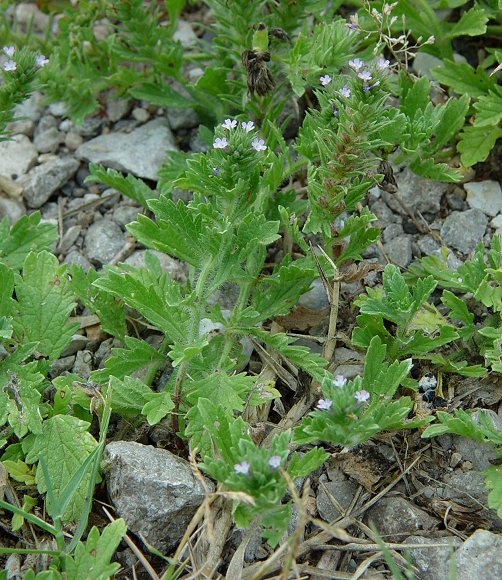Verbena bracteata Lag. & Rodr.
Creeping Vervain

Native
CC = 0
CW = 3
MOC = 66
© DETenaglia
Verbena bracteata Lag. & Rodr.Creeping Vervain | |
 |
Native CC = 0 CW = 3 MOC = 66 |
© DETenaglia |
|
Family - Verbenaceae Habit - Annual or perennial forb, sometimes forming mats. Stems - Loosely ascending or spreading with ascending tips, rarely more strongly ascending, to 50 cm, multiple from base, branching, slightly to moderately 4-angled, moderately to densely pubescent with nonglandular, straight to slightly curved, spreading, often pustular-based hairs.
Leaves - Opposite, sessile or with a winged petiole, the blades 1-5 cm long, lanceolate to ovate-lanceolate or oblanceolate, tapered to a slender, nonclasping base, rounded or broadly angled to a bluntly pointed tip, variously unlobed to pinnately or ternately deeply lobed, the margins also finely to coarsely toothed, occasionally only above the midpoint, both surfaces moderately to densely pubescent with loosely ascending, nonglandular, sometimes pustular-based hairs.
Inflorescences - Usually solitary spikes, 2-20 cm long, dense, the flowers strongly overlapping, relatively stout, elongating greatly with age. Bracts 8-15 mm long, 2-4 times as long as the calyx, narrowly lanceolate to narrowly elliptic.
Flowers - Calyces 3-4 mm long, 5-lobed, hairy. Corollas 4-6 mm long, 5-lobed, the outer surface glabrous, narrowly funnelform to somewhat trumpet-shaped, purplish blue, the tube relatively slender, the limb 2-3 mm in diameter. Stamens 4, didynamous, adnate near base of corolla tube, included. Filaments short. Anthers yellow, 0.2 mm long. Style short. Ovary of 2 carpels, 4-lobed.
Fruits - Nutlets 4, oblong, 2.0-2.5 mm long, oblong to narrowly oblong in outline, the inner surface usually pale and with dense, minute papillae, the outer surface yellowish brown to reddish brown, with several longitudinal ridges, these with several cross-ridges above the midpoint, enclosed within persistent calyx.
Flowering - April - October. Habitat - Streambanks, glades, disturbed portions of upland prairies, fields, pastures, railroads, roadsides, open disturbed areas. Origin - Native to the U.S. Other info. - Fortunately, not much close dissection is needed to properly identify this species. The flower parts are very small but the plant can be easily identified by looking at the hirsute stems, flower spikes, and leaves, as well as the tiny lavender flowers. This is somewhat of a pioneering species that is out-competed by larger plants. It occurs across most of Missouri and the continental U.S., though it is uncommon in the southeastern third of the country. This is a native plant, despite its weedy aspect and affinity for disturbed areas such as sidewalk cracks. Photographs taken in St. Louis, MO., 7-28-03 and 8-15-03 (DETenaglia); also in Washington, Franklin County, MO, 7-15-2018 (SRTurner). |